The NASA Electronic Parts and Packaging (NEPP) '02 Workshop
The NASA Electronic Parts and Packaging (NEPP) '02 Workshop
The NASA Electronic Parts and Packaging (NEPP) '02 Workshop
You also want an ePaper? Increase the reach of your titles
YUMPU automatically turns print PDFs into web optimized ePapers that Google loves.
Abstracts ________________________<br />
Session 1 – High Temperature Environments<br />
New <strong>and</strong> Emerging <strong>Packaging</strong> Technologies for Harsh<br />
Environments<br />
Robert S. Okojie<br />
<strong>NASA</strong> Glenn Research Center, 21000 Brookpark Road, Clevel<strong>and</strong>,<br />
Ohio 44135, USA.<br />
Abstract<br />
<strong>The</strong> keys to successful high-temperature Microsystems are the<br />
availability of stable high-temperature electronic components<br />
(integrated circuits, resistors, capacitors, etc.) <strong>and</strong> the packaging of<br />
these components using the proper materials. <strong>The</strong> development of<br />
silicon carbide integrated circuit (SiC IC) devices for use at<br />
temperatures up to 600°C has been well underway for these<br />
applications. Even though ceramic packages are available for<br />
room-temperature electronics, none of them is suitable to package<br />
SiC ICs for use over 300 o C. <strong>The</strong>refore, without parallel<br />
developments in packaging technology, the advances in SiC ICs<br />
will not much matter. Package selection <strong>and</strong> development are<br />
critical factors in meeting several key requirements: thermal <strong>and</strong><br />
electrical performance, cost, <strong>and</strong> form factor.<br />
Critical issues for high temperature (600 o C) package include the<br />
selection of a package design <strong>and</strong> package construction materials.<br />
Material properties can significantly impact how well the package<br />
can meet its requirements. <strong>The</strong> available materials primarily<br />
influence the design of high-temperature packages. This<br />
presentation will discuss the high-temperature package design <strong>and</strong><br />
associated materials issues for SiC devices for use at 600 o C.<br />
Speaker Biography<br />
Dr. Robert S. Okojie received the BS, MS <strong>and</strong> Ph.D. degrees in<br />
Electrical Engineering from the New Jersey Institute of Technology<br />
in 1991, 1993, <strong>and</strong> 1996, respectively. He worked at Kulite<br />
Semiconductor Products, Inc. from 1993 to 1997 as a Senior<br />
Research Scientist involved in implementing the <strong>NASA</strong>-sponsored<br />
program to develop 6H-SiC as a pressure sensor for high<br />
temperature applications, which he first reported in January, 1996.<br />
He joined Ford Microelectronics, Colorado Springs, CO, in 1997 as<br />
a Senior Research Engineer to develop new MEMS sensors,<br />
MEMS-based smart fuel injectors, <strong>and</strong> associated packaging. In<br />
June 1999, he joined the SiC research group at <strong>NASA</strong> Glenn<br />
Research Center, Clevel<strong>and</strong> OH, as an electronics engineer,<br />
primarily responsible for developing high temperature ohmic<br />
contacts enabling technology for SiC MEMS <strong>and</strong> electronics. He<br />
has published several papers in technical journals <strong>and</strong> conference<br />
proceedings <strong>and</strong> holds two patents <strong>and</strong> two pending. He is a<br />
member of Sigma Xi, Materials Research Society <strong>and</strong> IEEE.<br />
High Temperature Reliability of PEMs Using New Molding<br />
Compounds<br />
Patrick McCluskey, Arvind Ch<strong>and</strong>rasekaran, Casey O’Connor<br />
CALCE <strong>Electronic</strong> Products <strong>and</strong> Systems Center<br />
University of Maryl<strong>and</strong>, College Park, MD 20742<br />
Toru Kamei, Sumitomo Corporation Fort Lee, NJ <strong>and</strong> Anthony<br />
Gallo, Dexter <strong>Electronic</strong> Materials Corp. Olean, NY<br />
Abstract<br />
Over 97% of all integrated circuits produced today are available<br />
only in plastic encapsulated, surface mountable, commercial grade<br />
or industrial grade versions. This is especially true for the most<br />
9<br />
advanced technologies. <strong>The</strong> cost, availability, <strong>and</strong> functionality<br />
advantages of these devices are causing many electronics<br />
manufacturers to consider using them in elevated temperature<br />
applications such as avionics <strong>and</strong> automotive under-hood<br />
electronic systems to ensure early affordable access to leading<br />
edge technology. However, manufacturers only guarantee the<br />
operation of commercial devices in the 0°C to 70°C temperature<br />
range, <strong>and</strong> the industrial devices in the –40°C to 85°C temperature<br />
range.<br />
While previous studies have focused on the ability to use the<br />
semiconductor device outside of the datasheet temperature range,<br />
this paper describes the first study which addresses the packaging<br />
reliability of plastic encapsulated microcircuits (PEMs) in the range<br />
from 125°C to 300°C, well outside the manufacturer’s suggested<br />
temperature limits. This study revealed that st<strong>and</strong>ard industrial<br />
grade plastic encapsulated devices had less than half the lifespan<br />
at 180°C of similar devices packaged in hermetic ceramic<br />
packages. Outgassing of brominated flame-retardants with the<br />
associated catalysis of the growth of intermetallics was determined<br />
to be the principal cause of failure in the plastic components. Now,<br />
however, environmental considerations are leading manufacturers<br />
to create bromine-free molding compound formulations that use<br />
other techniques to ensure flame retardancy. <strong>The</strong>se new<br />
compounds promise removal of this catalytic effect <strong>and</strong> improved<br />
reliability for PEMs at temperatures above 150°C. We will discuss<br />
the relative availability <strong>and</strong> reliability of components packaged in<br />
these new compounds, along with studies conducted on 84-lead<br />
PQFP leadframes encapsulated in two different molding<br />
compounds that revealed that the bromine-free plastic encapsulant<br />
itself begins to lose its ability to insulate leads at temperatures<br />
greater than 250°C <strong>and</strong> can actually combust at temperatures<br />
greater than 300°C.<br />
Speaker Biography<br />
Patrick McCluskey is an Assistant Professor of Mechanical<br />
Engineering at the University of Maryl<strong>and</strong>, College Park where he<br />
is associated with the CALCE <strong>Electronic</strong> Products <strong>and</strong> Systems<br />
Center. He is the principal investigator for projects related to<br />
packaging <strong>and</strong> reliability of electronic components in high power<br />
<strong>and</strong> high temperature environments. He has co-developed <strong>and</strong><br />
taught graduate level <strong>and</strong> executive short courses on high<br />
temperature electronics, power electronics packaging, <strong>and</strong> plastic<br />
encapsulated microelectronics. He is the author or co-author of<br />
over 50 journal <strong>and</strong> proceedings articles on his research, <strong>and</strong> the<br />
co-author of two books on electronic packaging including High<br />
Temperature <strong>Electronic</strong>s. Dr. McCluskey received his Ph.D. in<br />
Materials Science <strong>and</strong> Engineering from Lehigh University in 1991.<br />
He is a member of IEEE, IMAPS, ASM, ECS, <strong>and</strong> MRS.<br />
Structure Optimization of Wire-bond for High Temperature<br />
Operation<br />
Shun-Tien Lin, Hamilton-Sundstr<strong>and</strong> Corp., Tel: 860-654-9205<br />
Email: shun.tien.lin@hs.utc.com<br />
And<br />
Xiaodong Luo, United Technologies Research Center<br />
Abstract<br />
Wire-bonds provide electrical connection between die <strong>and</strong> bond<br />
pads in microelectronic packages. <strong>The</strong> wire-bond is subjected to<br />
stresses during the operating life as a result of temperature <strong>and</strong>/or<br />
power cycling. Failure of the wire bond occurs predominantly as a<br />
result of thermo-mechanical fatigue. <strong>The</strong> dominant failure<br />
mechanism will depend on the operating environment, the wire,



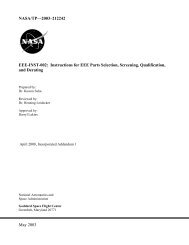

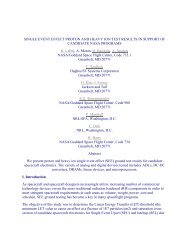
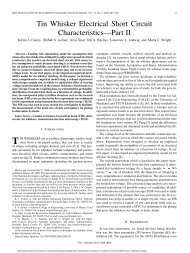
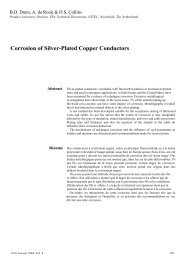
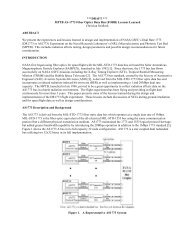

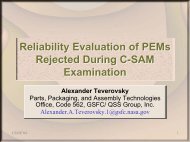
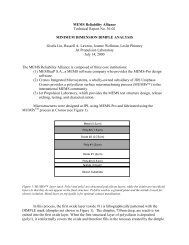
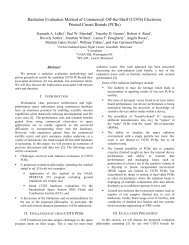
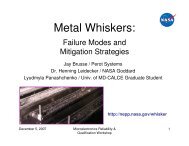
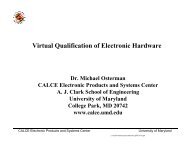
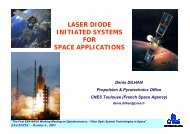
![mil-std-2223 [test methods for insulated electric wire] - NEPP](https://img.yumpu.com/4036001/1/190x249/mil-std-2223-test-methods-for-insulated-electric-wire-nepp.jpg?quality=85)